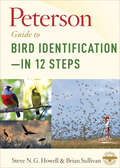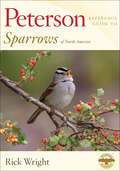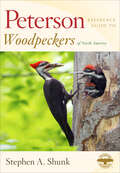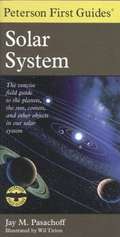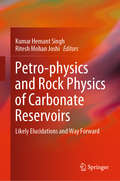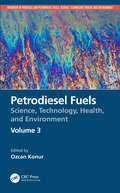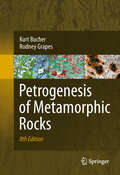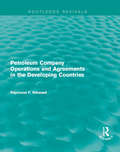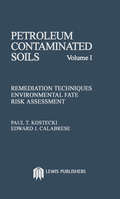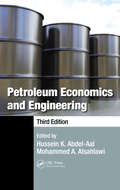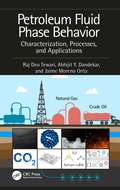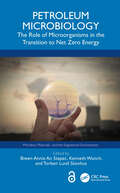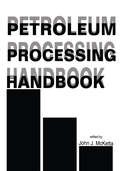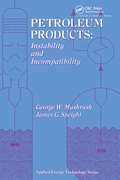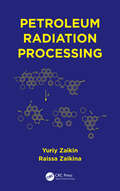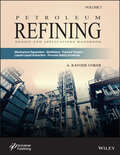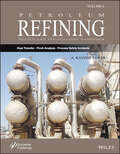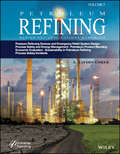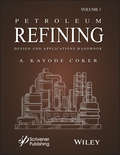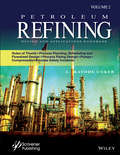- Table View
- List View
Peterson Guide To Bird Identification—in 12 Steps (The\crossover Ser.)
by Brian L. Sullivan N. G. Howell&“The birding equivalent of having Albert Einstein and Stephen Hawking teach you how to count, add, subtract, multiply, do long division, comprehend quantum mechanics, plus balance your checkbook. Bird watchers at every skill level will garner insights from this book.&” — Pete Dunne, author of Birds of Prey &“Identifying birds is a science and an art, involving far more than merely memorizing field marks. Steve Howell and Brian Sullivan are leading masters of this craft, and they share a wealth of inside knowledge in this gem of a book. If you're a birder at any level of experience, from beginner to expert, read this book from cover to cover and I guarantee it will improve your skills in the field.&” — Kenn Kaufman, author of the Kaufman Field Guide to Advanced Birding &“ . . . if you are going to have a book-based conversation with bird experts about identification, Howell and Sullivan are going to be at the top of the list. . . . [The Peterson Guide to Bird Identification—In 12 Steps] is a highly opinionated book reflecting the approach and thoughts of the authors. Which is exactly what makes it a book that all birders should read, consult, and maybe even, like me, read again.&” — Donna Schulman, 10,000 Birds.com &“This book is friendly, non-intimidating, and even humorous. New birders can acquire some basics from this handy little book, and experienced birders can pick up some vital pointers, especially useful when helping the uninitiated. . . . Basically, there is something in this short book for every birder, and the 152 pages present many opportunities for all birders to pick out and explore what that &‘something&’ may be.&” —Paul J. Baicich and Wayne Petersen, Birding Community E-bulletin —
Peterson Reference Guide To Sparrows of North America (Peterson Reference Guides)
by Rick WrightAn “entertaining” history and illustrated guide to seventy-six kinds of sparrows: “You will not find more complete or better written accounts of these birds.” —Minneapolis Star Tribune What, exactly, is a sparrow? All birders (and many non-birders) have essentially the same mental image of a pelican, a duck, or a flamingo, and a guide dedicated to waxwings or kingfishers would need nothing more than a sketch and a single sentence to satisfactorily identify its subject. Sparrows are harder to pin down. This book covers one family—Passerellidae—which includes towhees and juncos, and 76 members of the sparrow clan. Birds have a human history, too, beginning with their significance to native cultures and continuing through their discovery by science, their taxonomic fortunes and misfortunes, and their prospects for survival in a world with ever less space for wild creatures. This book includes not just facts and measurements, but stories—of how birds got their names and how they were discovered, and of their entanglement with our own species.
Peterson Reference Guide To Woodpeckers of North America (Peterson Field Guides)
by Stephen ShunkA complete guide to the natural history, ecology, and conservation of North America’s twenty-three woodpecker species.From the iconic Woody Woodpecker to the ubiquitous Northern Flicker, woodpeckers have long captivated our attention. Their astonishing anatomy makes them one of the most specialized bird families in the world, and their keystone ecological roles in our forests and woodlands makes them some of the most important birds on the continent.This comprehensive and authoritative guide to the natural history, ecology, and conservation of North America’s twenty-three woodpecker species goes far beyond identification. It explores their unique anatomy and their fascinating and often comical behaviors; it covers each species’ North American conservation status; and it showcases over 250 stunning photographs of woodpeckers in their natural habitats, plus easy-to-read figures and range maps. This reference guide is an essential addition to every birder’s library.
Peterson's First Guide to Seashores
by John KricherPeterson First Guides are the first books the beginning naturalist needs. Simplified versions of the famous Peterson Field Guides, the First Guides focus on the animals, plants, and other things you are most likely to see. They make it easy to get started in the field-and easy to graduate to the full-fledged Peterson Guides.
Peterson's First Guide to the Solar System
by Jay M. PasachoffA basic field guide for beginning observers of the solar system, introducing information on the locations and characteristics of the planets, sun, comets, meteors, and other objects in our solar system.
Petro-physics and Rock Physics of Carbonate Reservoirs: Likely Elucidations and Way Forward
by Kumar Hemant Singh Ritesh Mohan JoshiThis book presents selected articles from the workshop on "Challenges in Petrophysical Evaluation and Rock Physics Modeling of Carbonate Reservoirs" held at IIT Bombay in November 2017. The articles included explore the challenges associated with using well-log data, core data analysis, and their integration in the qualitative and quantitative assessment of petrophysical and elastic properties in carbonate reservoirs. The book also discusses the recent trends and advances in the area of research and development of carbonate reservoir characterization, both in industry and academia. Further, it addresses the challenging concept of porosity portioning, which has huge implications for exploration and development success in these complex reservoirs, enabling readers to understand the varying orders of deposition and diagenesis and also to model the flow and elastic properties.
Petrodiesel Fuels: Science, Technology, Health, and Environment (Handbook of Biodiesel and Petrodiesel Fuels)
by Ozcan KonurThis third volume of the handbook presents a representative sample of the population papers in the field of petrodiesel fuels. Following the substantial public concerns on the adverse impact of the emissions from petrodiesel fuels on the environment and human health, the research has intensified in the areas related to the reduction of these adverse effects. Thus, bioremediation of spills from crude oils and petrodiesel fuels at sea and soils as well as desulfurization of petrodiesel fuels have emerged as publicly important research areas. Similarly, the emissions from diesel fuel exhausts, due to their adverse effects on both human health and environment, have been researched more in recent years. These emissions cover particulate emissions, aerosol emissions, and NOx emissions. Research on the adverse impact of petrodiesel fuel exhaust emissions on human health has primarily progressed along the lines of respiratory illnesses, cancer, and other illnesses, such as cardiovascular illnesses, brain illnesses, and reproductive system illnesses, through human, animal, and in vitro studies. It is clear that these illnesses caused by the petrodiesel fuel exhaust emissions have been one of the most significant reasons to develop alternative biodiesel fuels. Part IX presents a representative sample of the population papers in the field of crude oils covering major research fronts. It covers crude oil spills in general, crude oil spills and their cleanup, properties and removal of crude oils, biodegradation of crude oil-contaminated soils, and crude oil recovery besides an overview paper. Part X presents a representative sample of the population papers in the field of petrodiesel fuels in general covering major research fronts. It covers combustion of biodiesel fuels in diesel engines, bioremediation of biodiesel fuel-contaminated soils, biodiesel power generation, and desulfurization of diesel fuels besides an overview paper. Part XI presents a representative sample of the population papers in the field of emissions from petrodiesel fuels covering major research fronts. It covers diesel emission mitigation, diesel particulate emissions, and diesel NOx emissions, besides an overview paper. Part XII presents a representative sample of the population papers in the field of the health impact of the emissions from petrodiesel fuels covering major research fronts. It covers respiratory illnesses, cancer, cardiovascular, brain, and reproductive system illnesses, besides an overview paper. This book will be useful to academics and professionals in the fields of Energy Fuels, Public Environmental Occupational Health, Pharmacology, Pharmacy, Immunology, Respiratory System, Allergy, and Oncology. Ozcan Konur is both a materials scientist and social scientist by training. He has published around 200 journal papers, book chapters, and conference papers. He has focused on the bioenergy and biofuels in recent years. In 2018, he edited Bioenergy and Biofuels, which brought together the work of over 30 experts in their respective field. He also edited the Handbook of Algal Science, Technology, and Medicine with a strong section on the algal biofuels in 2020.
Petrogenesis of Metamorphic Rocks
by Rodney Grapes Kurt BucherPetrogenesis of Metamorphic Rocks presents a large number of diagrams showing the stability relations among minerals and groups of minerals found in metamorphic rocks. The diagrams help to determine the pressure and temperature conditions under which a given set of metamorphic rocks may have formed. Other parameters that control metamorphic mineral assemblages are also discussed and pitfalls resulting from simplifications and generalizations are highlighted. The book discusses the most common metamorphic rock types, their nomenclature, structure and graphical representation of their mineral assemblages. Part I defines basic principles of metamorphism, introduces metamorphic processes, geologic thermometry and barometry and defines metamorphic grade. Part II presents in a systematic way mineralogical changes and assemblages found in the most common types of metamorphic rocks. The computation of diagrams is based on recent advances in quantitative petrology and geochemistry. An extensive bibliography, including the key contributions and classic papers in the field, make it an invaluable source book for graduate students and professional geologists.
Petroleum Biodegradation and Oil Spill Bioremediation
by James G. Speight Karuna K. ArjoonThe prime focus of the book is to determine the mechanism, extent, and efficiency of biodegradation processes, as it is necessary to know the composition of the original crude oil or crude oil product. The technology of bioremediation and the concerns of whether or not bioremediation technologies can accelerate this natural process enough to be considered practical, and, if so, whether they might find a niche as replacements for, or adjuncts to, other crude oil-spill response technologies. This book also introduces the reader to the science of the composition of crude oil and crude oil products is at the core of understanding the chemistry of biodegradation and bioremediation processes.
Petroleum Bioventing
by J. van EykPetroleum bioventing is a new technique for the biological in situ removal of petroleum hydrocarbons from soil. This book investigates the composition and the behaviour of petroleum in soil, soil properties and soil processes, their interaction with bacterial processes, possibilities for optimizing the removal of petroleum hydrocarbons from soil by bacteria and it explains the phenomenon of recalcitrance. This interdisciplinary approach forms the basis for both modelling and design principles of bioventing. Key features: Background knowledge on the physical/chemical/biogeochemical properties of soil and soil processes with respect to petroleum bioventing; Background knowledge on petroleum biodegradation and noval approaches to stimulate petroleum biodegradation to stimulate petroleum biodegradation in soil and biofilters; Modelling efforts showing the effect of diffusion and soil porosity on bioventing design and the effect of ventilation quotients on the aeration & biological clean up of soils, particularly heterogeneous soils; New insights into biological removal of priority pollutants from petroleum hydrocarbons, the problem of residual concentrations of petroleum hydrocarbons in soil & the requirements by the Law on Soil Protection.
Petroleum Chemistry And Refining
by James G. SpeightSupported by numerous illustrations and references, this book describes the chemistry and physics that occur during the refinery operations, and how the properties of petroleum can be translated into predictability in refinery scenarios. The chapters discuss such topics as: the composition of petroleum, petroleum analysis and evaluation; metals and
Petroleum Company Operations and Agreements in the Developing Countries (Routledge Revivals)
by Raymond F. MikesellOriginally published in 1984, this study focuses on petroleum agreements between non-OPEC LDCs with oil-importing LDCs and how issues such as high oil prices affect each country. The information presented in this study was drawn from interviews with petroleum officials in petroleum companies, petroleum ministries and unpublished documents such as contracts and focussing on case studies of countries such as Peru, Guatemala and Malaysia. This title will be of interest to students of environmental studies and economics.
Petroleum Contaminated Soils, Volume I: Remediation Techniques, Environmental Fate, and Risk Assessment
by Paul T. KosteckiThese three volumes provide valuable information to help bring rational and scientifically feasible solutions to petroleum contaminated soils. State-of-the-art information on both technical and regulatory issues is covered, including environmental fate, health effects, risk assessment and remedial alternatives. They show why petroleum contaminated soils are a problem - and propose solutions for that problem. These books are an excellent reference for regulatory personnel and environmental consultants at all levels.
Petroleum Economics and Engineering
by Mohammed A. Alsahlawi Hussein K. Abdel-AalThis book explains how to apply economic analysis to the evaluation of engineering challenges in the petroleum industry. Discussion progresses from an introduction to the industry, through principles and techniques of engineering economics, to the application of economic methods. Packed with real-world examples and case studies demonstrating how to
Petroleum Fluid Phase Behavior: Characterization, Processes, and Applications (Emerging Trends and Technologies in Petroleum Engineering)
by Abhijit Y. Dandekar Raj Deo Tewari Jaime Moreno OrtizThis book deals with complex fluid characterization of oil and gas reservoirs, emphasizing the importance of PVT parameters for practical application in reservoir simulation and management. It covers modeling of PVT parameters, QA/QC of PVT data from lab studies, EOS modeling, PVT simulation and compositional grading and variation. It describes generation of data for reservoir engineering calculations in view of limited and unreliable data and techniques like downhole fluid analysis and photophysics of reservoir fluids. It discusses behavior of unconventional reservoirs, particularly for difficult resources like shale gas, shale oil, coalbed methane, reservoirs, heavy and extra heavy oils.
Petroleum Microbiology: The Role of Microorganisms in the Transition to Net Zero Energy (Microbes, Materials, and the Engineered Environment)
by Torben Lund Skovhus Kenneth Wunch Biwen Annie An StepecIn the oil and gas industry, technologies have been developed to address microbial-related issues such as oil field souring, microbiologically influenced corrosion, biofouling, and targeted measures for risk assessment and mitigation. Microorganisms have also benefited the oil sector through microbial-enhanced oil recovery and bioremediation of petroleum-contaminated environments. However, during the current transitional phase in the oil and gas industry, the role of the microbiome within the current infrastructure and its potential impact on future systems remains an open question. Petroleum Microbiology: The Role of Microorganisms in the Transition to Net Zero Energy explores technological advances in applied microbiology in the oil and gas sector that can be utilized in its transition to renewable energy systems. • Provides insights on the potential of applying microbiological techniques in oil systems to pave the way to achieving net-zero energy.• Presents the major industrial problems caused by microbes and their beneficial activities from both fundamental and applied perspectives.• Covers such technologies as next-generation sequencing, sampling, and diagnostics.• Offers a solid foundation on the importance of microbes to key aspects of the energy industry.• Seeks to answer the question: what role will microorganisms play in the evolution of energy systems?Featuring chapters from interdisciplinary experts spanning academia and industry, this is an excellent reference for microbial ecologists, molecular biologists, operators, engineers, chemists, and academics involved in the oil and gas sector, working toward energy transition.The Open Access version of this book, available at http://www.taylorfrancis.com, has been made available under a Creative Commons [Attribution-Non Commercial-No Derivatives (CC-BY-NC-ND)] 4.0 license.
Petroleum Processing Handbook
by John J. McKettaA reference that details the pertinent chemical reactions and emphasizes the plant design and operations of petroleum processing procedures. The handbook is divided into four sections: products, refining, manufacturing processes, and treating processes. Wherever possible, shortcut methods of calcula
Petroleum Products: Instability And Incompatibility
by George MushrushThis book provides an overview of the chemical and physical concepts of instability and incompatibility of petroleum and liquid fuels. It helps the petroleum refinery personnel to handle liquid fuels from other sources as feedstocks for the refinery system.
Petroleum Radiation Processing
by Yuriy Zaikin Raissa ZaikinaThis book presents a summary of the research progress in the field of petroleum radiation processing, which has produced technology that offers effective and economic solutions for some pressing oil refining challenges. It provides a systematic description of the most important experiments on radiation cracking for different types of petroleum feedstock, including crude oils, heavy oil residues, and bitumen. The book provides a detailed introduction to radiation methods based on radiation-thermal and low-temperature cracking of hydrocarbons, emphasizing high-viscous oil feedstocks that are difficult to process by conventional methods.
Petroleum Refinery Process Modeling: Integrated Optimization Tools and Applications
by Ai-Fu Chang Kiran Pashikanti Y. A. LiuThe book supports operators and engineers of any experience level in how to quantitatively model key refinery reaction and fractionation processes. Chapter 1 introduces the reader to the basics of dealing with the thermodynamics and physical property predictions of hydrocarbon components in the context of process modeling. Chapters 2 and 3 use the key concepts of fractionation lumps and physical properties to develop detailed models and workflows for atmospheric (CDU) and vacuum (VDU) distillation units. Chapters 4, 5 and 6 are largely self-contained that discuss modeling FCC, catalytic reforming and hydroprocessing units.
Petroleum Refining Design and Applications Handbook, Volume 3: Mechanical Separations, Distillation, Packed Towers, Liquid-Liquid Extraction, Process Safety Incidents
by A. Kayode CokerPETROLEUM REFINING The third volume of a multi-volume set of the most comprehensive and up-to-date coverage of the advances of petroleum refining designs and applications, written by one of the world’s most well-known process engineers, this is a must-have for any chemical, process, or petroleum engineer. This volume continues the most up-to-date and comprehensive coverage of the most significant and recent changes to petroleum refining, presenting the state-of-the-art to the engineer, scientist, or student. This book provides the design of process equipment, such as vessels for the separation of two-phase and three-phase fluids, using Excel spreadsheets, and extensive process safety investigations of refinery incidents, distillation, distillation sequencing, and dividing wall columns. It also covers multicomponent distillation, packed towers, liquid-liquid extraction using UniSim design software, and process safety incidents involving these equipment items and pertinent industrial case studies. Useful as a textbook, this is also an excellent, handy go-to reference for the veteran engineer, a volume no chemical or process engineering library should be without. Written by one of the world’s foremost authorities, this book sets the standard for the industry and is an integral part of the petroleum refining renaissance. It is truly a must-have for any practicing engineer or student in this area. This groundbreaking new volume: Assists engineers in rapidly analyzing problems and finding effective design methods and select mechanical specifications Provides improved design manuals to methods and proven fundamentals of process design with related data and charts Covers a complete range of basic day–to–day petroleum refining operations topics with new materials on significant industry changes Includes extensive Excel spreadsheets for the design of process vessels for mechanical separation of two-phase and three-phase fluids Provides UniSim ®-based case studies for enabling simulation of key processes outlined in the book Helps achieve optimum operations and process conditions and shows how to translate design fundamentals into mechanical equipment specifications Has a related website that includes computer applications along with spreadsheets and concise applied process design flow charts and process data sheets Provides various case studies of process safety incidents in refineries and means of mitigating these from investigations by the US Chemical Safety Board Includes a vast Glossary of Petroleum and Technical Terminology
Petroleum Refining Design and Applications Handbook, Volume 4: Heat Transfer, Pinch Analysis, and Process Safety Incidents
by A. Kayode CokerPETROLEUM REFINING This fourth volume in the Petroleum Refining set, this book continues the most up-to-date and comprehensive coverage of the most significant and recent changes to petroleum refining, presenting the state-of-the-art to the engineer, scientist, or student. This book provides the design of heat exchanger equipment, crude oil fouling in pre-heat train exchangers, crude oil fouling models, fouling mitigation and monitoring, prevention and control of liquid and gas side fouling, using the Excel spreadsheet and UniSim design software for the design of shell and tube heat exchangers, double pipe heat exchangers, air-cooled exchangers, heat loss tracing for process piping, pinch analysis for hot and cold utility targets and process safety incidents involving these equipment items and pertinent industrial case studies. Use of UniSim Design (UniSim STE) software is illustrated in further elucidation of the design of shell and tube heat exchangers, condensers, and UniSim ExchangerNet R470 for the design of heat exchanger networks using pinch analysis. This is important for determining minimum cold and hot utility requirements, composite curves of hot and cold streams, the grand composite curve, the heat exchanger network, and the relationship between operating cost index target and the capital cost index target against ΔTmin. Useful as a textbook, this is also an excellent, handy go-to reference for the veteran engineer, a volume no chemical or process engineering library should be without. Written by one of the world’s foremost authorities, this book sets the standard for the industry and is an integral part of the petroleum refining renaissance. It is truly a must-have for any practicing engineer or student in this area. This groundbreaking new volume: Assists engineers in rapidly analyzing problems and finding effective design methods and select mechanical specifications Provides improved design manuals to methods and proven fundamentals of process design with related data and charts Covers a complete range of basic day–to–day petroleum refining operations topics with new materials on significant industry changes Extensive Excel spreadsheets for the design of process vessels for mechanical separation of two-phase and three-phase fluids, double-pipe heat exchanger, air-cooled exchanger, pinch analysis for hot and cold utility targets. Provides UniSim ®-based case studies for enabling simulation of key processes outlined in the book Helps achieve optimum operations and process conditions and shows how to translate design fundamentals into mechanical equipment specifications Has a related website that includes computer applications along with spreadsheets and concise applied process design flow charts and process data sheets Provides various case studies of process safety incidents in refineries and means of mitigating these from investigations by the US Chemical Safety Board Includes a vast Glossary of Petroleum and Technical Terminology
Petroleum Refining Design and Applications Handbook, Volume 5: Pressure Relieving Devices and Emergency Relief System Design, Process Safety and Energy Management, Product Blending, Cost Estimation and Economic Evaluation, Sustainability in Petroleum Refining
by A. Kayode CokerPETROLEUM REFINING With no new refineries having been built in decades, companies continue to build onto or reverse engineer and re-tool existing refineries. With so many changes in the last few years alone, books like this are very much in need. There is truly a renaissance for chemical and process engineering going on right now across multiple industries. This fifth and final volume in the “Petroleum Refining Design and Applications Handbook” set, this book continues the most up-to-date and comprehensive coverage of the most significant and recent changes to petroleum refining, presenting the state-of-the-art to the engineer, scientist, or student. Besides the list below, this groundbreaking new volume describes blending of products from the refinery, applying the ternary diagrams and classifications of crude oils, flash point blending, pour point blending, aniline point blending, smoke point and viscosity blending, cetane and diesel indices. The volume further reviews refinery operational cost, cost allocation of actual usage, project and economic evaluation involving cost estimation, cash flow involving return on investment, net present values, discounted cash flow rate of return, net present values, payback period, inflation and sensitivity analysis, and so on. It reviews global effects on the refining economy, carbon tax, carbon foot print, global warming potential, carbon dioxide equivalent, carbon credit, carbon offset, carbon price, and so on. It reviews sustainability in petroleum refining and alternative fuels (biofuels and so on), impact of the overall greenhouse effects, carbon capture and storage in refineries, process intensification in biodiesel, biofuel from green diesel, acid-gas removal and emerging technologies, carbon capture and storage, gas heated reformer unit, pressure swing adsorption process, steam methane reforming for fuel cells, grey, blue and green hydrogen production, new technologies for carbon capture and storage, carbon clean process design, refinery of the future, refining and petrochemical industry characteristics. The text is packed with Excel spreadsheet calculations and Honeywell UniSim Design software in some examples, and it includes an invaluable glossary of petroleum and petrochemical technical terminologies. Useful as a textbook, this is also an excellent, handy go-to reference for the veteran engineer, a volume no chemical or process engineering library should be without. Written by one of the world’s foremost authorities, this book sets the standard for the industry and is an integral part of the petroleum refining renaissance. It is truly a must-have for any practicing engineer or student in this area.
Petroleum Refining Design and Applications Handbook: Designs And Applications Handbook
by A. Kayode CokerThere is a renaissance that is occurring in chemical and process engineering, and it is crucial for today’s scientists, engineers, technicians, and operators to stay current. With so many changes over the last few decades in equipment and processes, petroleum refining is almost a living document, constantly needing updating. With no new refineries being built, companies are spending their capital re-tooling and adding on to existing plants. Refineries are like small cities, today, as they grow bigger and bigger and more and more complex. A huge percentage of a refinery can be changed, literally, from year to year, to account for the type of crude being refined or to integrate new equipment or processes. This book is the most up-to-date and comprehensive coverage of the most significant and recent changes to petroleum refining, presenting the state-of-the-art to the engineer, scientist, or student. Useful as a textbook, this is also an excellent, handy go-to reference for the veteran engineer, a volume no chemical or process engineering library should be without. Written by one of the world’s foremost authorities, this book sets the standard for the industry and is an integral part of the petroleum refining renaissance. It is truly a must-have for any practicing engineer or student in this area.
Petroleum Refining Design and Applications Handbook: Rules of Thumb, Process Planning, Scheduling, and Flowsheet Design, Process Piping Design, Pumps, Compressors, and Process Safety Incidents
by A. Kayode CokerA must-read for any practicing engineer or student in this area There is a renaissance that is occurring in chemical and process engineering, and it is crucial for today's scientists, engineers, technicians, and operators to stay current. This book offers the most up-to-date and comprehensive coverage of the most significant and recent changes to petroleum refining, presenting the state-of-the-art to the engineer, scientist, or student. Useful as a textbook, this is also an excellent, handy go-to reference for the veteran engineer, a volume no chemical or process engineering library should be without.
